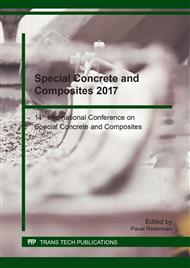[1]
O. Zobal, Use of fly ash in cement binder and concrete, PhD Thesis, Czech Technical University in Prague, Faculty of Civil Engineering. (2017).
Google Scholar
[2]
W. Kubissa, R. Jaskulski, P. Reiterman, Ecological Concrete Based on Blast-Furnace Cement with Incorporated Coarse Recycled Concrete Aggregate and Fly Ash Addition, Journal of Renewable Materials 5 (2017) 53-61.
DOI: 10.7569/jrm.2017.634103
Google Scholar
[3]
Information on http: /www. bbc. com/news/world-middle-east-36848521.
Google Scholar
[4]
Information on http: /www. bbc. com/news/uk-england-london-40272168¨.
Google Scholar
[5]
Information on http: /www. bbc. com/news/world-middle-east-40822269.
Google Scholar
[6]
M. Broucek, M. Sejnoha, P. Reiterman, Fiber Reinforced Fly Ash Concrete and Extreme Fires, Key Engineering Materials 722 (2017) 12-17.
DOI: 10.4028/www.scientific.net/kem.722.12
Google Scholar
[7]
M. S. Khan, J. Prasad, H. Abbas, Effect of High Temperature on High-Volume Fly Ash Concrete, Arabian Journal for Science and Engineering, 2013, Volume 38, Number 6, Page 1369, https: /doi. org/10. 1007/s13369-013-0606-1.
DOI: 10.1007/s13369-013-0606-1
Google Scholar
[8]
Arabi N.S. Al Qadi, Sleiman M. Al-Zaidyeen, Effect of fibre content and specimen shape on residual strength of polypropylene fibre self-compacting concrete exposed to elevated temperatures, In Journal of King Saud University - Engineering Sciences, Volume 26, Issue 1, 2014, Pages 33-39, ISSN 1018-3639, https: /doi. org/10. 1016/j. jksues. 2012. 12. 002.
DOI: 10.1016/j.jksues.2012.12.002
Google Scholar
[9]
H. Cheng-Yong, et al. Thermal Resistance Variations of Fly Ash Geopolymers: Foaming Responses. Sci. Rep. 7, 45355; doi: 10. 1038/srep45355 (2017).
DOI: 10.1038/srep45355
Google Scholar
[10]
J. Kotatkova, J. Zatloukal, P. Reiterman, J. Patera, Z. Hlavac, P. Brabec, The effect of elevated temperatures and nuclear radiation on the properties of biological shielding concrete, Key Engineering Materials 677 (2016) 8-16.
DOI: 10.4028/www.scientific.net/kem.677.8
Google Scholar
[11]
P. Padevět; R. Lovichová, The Changes of Material Properties of the Cement Paste with Fly Ash Exposed to High Temperatures, WSEAS Transactions on Applied and Theoretical Mechanics. 2013, 2013(4), 304-312. ISSN 1991-8747. ¨.
DOI: 10.4028/www.scientific.net/amr.742.187
Google Scholar
[12]
M.J. McCarthy, R.K. Dhir: Development of high volume fly ash cements for use in concrete construction, Fuel, 1423-1432, (2005).
DOI: 10.1016/j.fuel.2004.08.029
Google Scholar
[13]
A. M. Neville. Properties of concrete. 2009. New York. pp.503-505. ISBN 0-582-23070-5.
Google Scholar
[14]
D.P. Bentz, C.F. Ferraris, I. De la Varga, M.A. Peltz, and J.A. Winpigler: Mixture Proportioning Options for Improving High Volume Fly Ash Concretes, Int. J. Pavement Res. Technol. 3(5): 234-240, (2010).
Google Scholar
[15]
R. Siddique: Performance characteristics of high-volume Class F fly ash concrete, Cement and Concrete Research 34, 487-493, (2011).
DOI: 10.1016/j.cemconres.2003.09.002
Google Scholar
[16]
O. Zobal, V. Šmilauer, L. Kopecký, et al., Analysis of concrete from the body of the Orlik dam after fifty years, In: Beton – technologie, konstrukce, sanace, 02/2014, pp.19-25. ISSN 1213-3116.
Google Scholar


